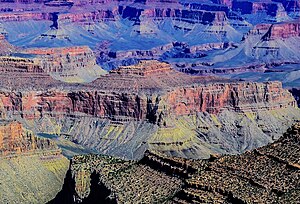Earth:Lyell Butte
| Lyell Butte | |
|---|---|
 Lyell Butte, south aspect | |
| Highest point | |
| Elevation | 5,362 ft (1,634 m) [1] |
| Prominence | 502 ft (153 m) [1] |
| Parent peak | Newton Butte (5,940 ft)[1] |
| Isolation | 1.55 mi (2.49 km) [1] |
| Coordinates | [ ⚑ ] : 36°02′49″N 112°01′44″W / 36.0470086°N 112.0288279°W [2] |
| Naming | |
| Etymology | Charles Lyell |
| Geography | |
Lua error in Module:Location_map at line 522: Unable to find the specified location map definition: "Module:Location map/data/Arizona" does not exist.
| |
| Location | Grand Canyon National Park Coconino County, Arizona, US |
| Parent range | Coconino Plateau Colorado Plateau |
| Topo map | USGS Phantom Ranch |
| Geology | |
| Type of rock | sandstone, limestone, shale |
| Climbing | |
| First ascent | 1970 |
| Easiest route | class 4 climbing[1] |
Lyell Butte is a 5,362-foot (1,634 m) elevation summit located in the Grand Canyon, in Coconino County of northern Arizona, United States.[2] It is situated six miles (9.7 km) east of Grand Canyon Village, immediately east of and below Shoshone Point, and 1.5 mile southeast of Newton Butte, which is the nearest higher neighbor. Topographic relief is significant as Lyell Butte rises 2,800 feet (850 m) above the Colorado River in 1.5 mile (2.4 km). Access is via the Tonto Trail which traverses the base of the peak. According to the Köppen climate classification system, Lyell Butte is located in a cold semi-arid climate zone, with precipitation runoff draining northeast to the Colorado River via Grapevine and Boulder Creeks.[3]
History
Lyell Butte was named in 1906 after Sir Charles Lyell (1797–1875), eminent Scottish geologist best known as the author of Principles of Geology.[4] This feature's name was officially adopted in 1906 by the U.S. Board on Geographic Names.[2] The first ascent of Lyell Butte was made January 24, 1970, by Alan Doty via the northwest face/chimney.[5][6]
Geology
Lyell Butte is composed of Mississippian Redwall Limestone, with a dome of the basal layer of Pennsylvanian-Permian Supai Group on top which dips to the northeast.[7] The cliff-forming Redwall overlays the Cambrian Tonto Group, and below that Paleoproterozoic Vishnu Basement Rocks at river level in Granite Gorge.[8]
See also
- Geology of the Grand Canyon area
References
- ↑ 1.0 1.1 1.2 1.3 1.4 "Lyell Butte – 5,362' AZ". https://listsofjohn.com/peak/74910.
- ↑ 2.0 2.1 2.2 "Lyell Butte". United States Geological Survey. https://geonames.usgs.gov/apex/f?p=gnispq:3:::NO::P3_FID:7553.
- ↑ Peel, M. C.; Finlayson, B. L.; McMahon, T. A. (2007). "Updated world map of the Köppen−Geiger climate classification". Hydrol. Earth Syst. Sci. 11. ISSN 1027-5606.
- ↑ Randy Moore and Kara Felicia Witt, The Grand Canyon: An Encyclopedia of Geography, History, and Culture, 2018, ABC-CLIO Publisher, p. 159.
- ↑ Harvey Butchart, Grand Canyon Treks 12,000 Miles Through the Grand Canyon, 1998, Spotted Dog Press, p. 131.
- ↑ Aaron Tomasi, Grand Canyon Summits Select An Obscure Compilation of Sixty-nine Remote Ascent Routes in the Grand Canyon National Park Backcountry, 2001, ISBN:9780971088009, p. 47.
- ↑ N.H. Darton, Story of the Grand Canyon of Arizona, 1917, pp. 12, 62.
- ↑ William Kenneth Hamblin, Anatomy of the Grand Canyon: Panoramas of the Canyon's Geology, 2008, Grand Canyon Association Publisher, ISBN:9781934656013.
External links
- Weather forecast: National Weather Service
Template:Geographic Location 2
 |



